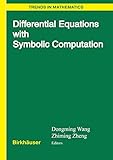Differential Equations with Symbolic Computation / edited by Dongming Wang, Zhiming Zheng.
Tipo de material: TextoSeries Trends in MathematicsEditor: Basel : Birkhäuser Basel, 2005Descripción: viii, 374 páginas recurso en líneaTipo de contenido:
TextoSeries Trends in MathematicsEditor: Basel : Birkhäuser Basel, 2005Descripción: viii, 374 páginas recurso en líneaTipo de contenido: - texto
- computadora
- recurso en línea
- 9783764374297
- QA370-380
Springer eBooks
Symbolic Computation of Lyapunov Quantities and the Second Part of Hilbert’s Sixteenth Problem -- Estimating Limit Cycle Bifurcations from Centers -- Conditions of Infinity to be an Isochronous Center for a Class of Differential Systems -- Darboux Integrability and Limit Cycles for a Class of Polynomial Differential Systems -- Time-Reversibility in Two-Dimensional Polynomial Systems -- On Symbolic Computation of the LCE of N-Dimensional Dynamical Systems -- Symbolic Computation for Equilibria of Two Dynamic Models -- Attractive Regions in Power Systems by Singular Perturbation Analysis -- Algebraic Multiplicity and the Poincaré Problem -- Formalizing a Reasoning Strategy in Symbolic Approach to Differential Equations -- Looking for Periodic Solutions of ODE Systems by the Normal Form Method -- Algorithmic Reduction and Rational General Solutions of First Order Algebraic Differential Equations -- Factoring Partial Differential Systems in Positive Characteristic -- On the Factorization of Differential Modules -- Continuous and Discrete Homotopy Operators and the Computation of Conservation Laws -- Partial and Complete Linearization of PDEs Based on Conservation Laws -- CONSLAW: A Maple Package to Construct the Conservation Laws for Nonlinear Evolution Equations -- Generalized Differential Resultant Systems of Algebraic ODEs and Differential Elimination Theory -- On “Good” Bases of Algebraico-Differential Ideals -- On the Construction of Groebner Basis of a Polynomial Ideal Based on Riquier—Janet Theory.
This book presents the state of the art in tackling differential equations using advanced methods and software tools of symbolic computation. It focuses on the symbolic-computational aspects of three kinds of fundamental problems in differential equations: transforming the equations, solving the equations, and studying the structure and properties of their solutions. The 20 chapters are written by leading experts and are structured into three parts. The book is worth reading for researchers and students working on this interdisciplinary subject but may also serve as a valuable reference for everyone interested in differential equations, symbolic computation, and their interaction.
Para consulta fuera de la UANL se requiere clave de acceso remoto.


